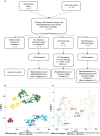Medulloblastoma in children with Fanconi anemia: Association with FA-D1/FA-N, SHH type and poor survival independent of treatment strategies
- PMID: 38919026
- PMCID: PMC11534319
- DOI: 10.1093/neuonc/noae111
Medulloblastoma in children with Fanconi anemia: Association with FA-D1/FA-N, SHH type and poor survival independent of treatment strategies
Abstract
Background: The outcome of children with medulloblastoma (MB) and Fanconi Anemia (FA), an inherited DNA repair deficiency, has not been described systematically. Treatment is complicated by high vulnerability to treatment-associated side effects, yet structured data are lacking. This study aims to give a comprehensive overview of clinical and molecular characteristics of pediatric FA MB patients.
Methods: Clinical data including detailed information on the treatment and toxicities of 6 previously unreported FA MB patients were supplemented with data of 16 published cases.
Results: We identified 22 cases of children with FA and MB with clinical data available. All MBs with subgroup reporting were SHH-activated (n = 9), confirmed by methylation profiling in 5 patients. FA MB patients exclusively belonged to complementation groups FA-D1 (n = 16) or FA-N (n = 3). Patients were treated with postoperative chemotherapy only (50%) or radiotherapy (RT) ± chemotherapy (27%). Of 23% did not receive adjuvant therapy. Excessive treatment-related toxicities were frequent. Severe hematological toxicity occurred in 91% of patients treated with alkylating chemotherapy, while non-alkylating agents and RT were less toxic. Median overall survival (OS) was 1 year (95%CI: 0.3-1.8). 1-year-progression-free-survival (PFS) was 26.3% ± 10.1% and 1-year-OS was 42.1% ± 11.3%. Adjuvant therapy prolonged survival (1y-OS/1y-PFS 0%/0% without adjuvant therapy vs. 53.3% ± 12.9%/33.3 ± 12.2% with adjuvant therapy, P = .006/P = .086).
Conclusions: MB in FA patients is strongly associated with SHH activation and FA-D1/FA-N. Despite the dismal prognosis, adjuvant therapy may prolong survival. Non-alkylating chemotherapy and RT are feasible in selected patients with careful monitoring of toxicities and dose adjustments. Curative therapy for FA MB-SHH remains an unmet medical need.
Keywords: FA-D1; FA-N; Fanconi anemia; medulloblastoma; tumor predisposition.
© The Author(s) 2024. Published by Oxford University Press on behalf of the Society for Neuro-Oncology. All rights reserved. For commercial re-use, please contact reprints@oup.com for reprints and translation rights for reprints. All other permissions can be obtained through our RightsLink service via the Permissions link on the article page on our site—for further information please contact journals.permissions@oup.com.
Conflict of interest statement
PHD is the international coordinating investigator of the Sprinkle study and advisory board member for Alexion. URK is part of a data safety monitoring board or advisory board for Astra Zeneca and Merck and received support for attending meetings and/or travel from Astra Zeneca. RS receives funds from the German Childhood Cancer Foundation for quality assurance of radiotherapy in pediatric brain tumors in Germany and is part of a data safety monitoring board or advisory board for the Oscar 1 Trial (Osteosarcoma) of University Hospital Heidelberg, Germany, and for proton therapy trials of University Hospital Dresden, Germany. TP receives funds for the Brain Tumor Reference Center for reference neuropathological assessments in the HIT network by the German Childhood Cancer Foundation. SR received fees for advisory board roles from Bayer, Novartis, BMS, and Roche; for DMSC from Celegne; for assessment from the German Childhood Cancer Foundation; and from MyChildsCancer for consulting. The other authors have no competing interests to declare that are relevant to the content of this article.
Figures




References
MeSH terms
Substances
Grants and funding
LinkOut - more resources
Full Text Sources
Miscellaneous

